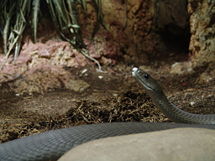Mamba
| Dendroaspis | ||||||||||||||
|---|---|---|---|---|---|---|---|---|---|---|---|---|---|---|
 Black Mamba
| ||||||||||||||
| Scientific classification | ||||||||||||||
| ||||||||||||||
|
Mamba is the common name for any of the several venomous African snakes comprising the elapid genus Dendroaspis, characterized by large scales, large eyes, extremely toxic venom, absence of hoods, and, as with other members of the Elapidae family, hollow, relatively short, permanently erect fangs in the front of the mouth that deliver the venom. The black mamba (D. polylepis) is particular well-known for its extremely potent neurotoxic venom and sometimes aggressive nature towards humans; without antivenom, its bite is nearly always fatal. With the exception of the black mamba, which is a ground dwelling species, other Dendroaspis species are more strongly arboreal.
Overview and description
Mambas are related to the cobras (Elapids), as can be seen during their threat display, when they stretch a slightly smaller 'hood' while gaping their mouth. Unlike most other snakes mambas will strike repeatedly if cornered, and have been reported to bring down a giraffe and a lion with their venom.
are fast-moving land-dwelling snakes of Africa. ("Dendroaspis" is literally "tree snake".) They belong to the family of Elapidae which includes cobras, coral snakes, kraits and, debatably, sea snakes although these are now classed as Hydrophiidae, all of which can be extremely deadly. The black mamba is the longest venomous snake in Africa, with an extremely potent neurotoxic venom that attacks the nervous system, and cardiotoxins which attack the heart; the bite is often fatal to humans without access to proper first aid and subsequent antivenin treatment, because it shuts down the lungs and heart. Prior to the availability of antivenom, envenomations by members of this genus carried a nearly 100% fatality rate. However, with antivenom being much more available today, fatalities have become much more rare.
The Western green mamba (D. viridis) and Eastern green mamba, (D. angusticeps), possess venom that is roughly equal in potency to that of the Black mamba (D. polylepis). However, they are not nearly as aggressive. They are slightly smaller, and are arboreal, whereas the latter is primarily terrestrial.
The black mamba is not named for the colour of its body (which is usually a shade of grey or charcoal), but for the highly pigmented interior of its mouth, which it will display to the predator in hopes it will leave it alone. Many people believe that the Black Mamba will actually chase and attack humans. This is a myth, and is probably fueled by the great speed with which this species can move. Humans are actually their predators, rather than their prey. For that reason, mambas generally avoid contact with humans. However, if a mamba feels threatened by a human, it may defend itself fiercely.
In contrast to all other species in this genus, which are arboreal, black mambas reside in hollow insect mounds, abandoned burrows, and rock crevices. They are diurnal. During the day they actively hunt their prey of small mammals, birds and lizards. They return to the same lair nightly.
Mambas are related to the cobras (Elapids), as can be seen during their threat display, when they stretch a slightly smaller 'hood' while gaping their mouth. Unlike most other snakes mambas will strike repeatedly if cornered, and have been reported to bring down a giraffe and a lion with their venom.
Mamba toxin
Mamba toxin is in fact several components, with different targets. Examples are:
ReferencesISBN links support NWE through referral fees
- ↑ 1.0 1.1 Rang, H. P. (2003). Pharmacology. Edinburgh: Churchill Livingstone, 139. ISBN 0-443-07145-4.
External links
Credits
New World Encyclopedia writers and editors rewrote and completed the Wikipedia article in accordance with New World Encyclopedia standards. This article abides by terms of the Creative Commons CC-by-sa 3.0 License (CC-by-sa), which may be used and disseminated with proper attribution. Credit is due under the terms of this license that can reference both the New World Encyclopedia contributors and the selfless volunteer contributors of the Wikimedia Foundation. To cite this article click here for a list of acceptable citing formats.The history of earlier contributions by wikipedians is accessible to researchers here:
The history of this article since it was imported to New World Encyclopedia:
Note: Some restrictions may apply to use of individual images which are separately licensed.